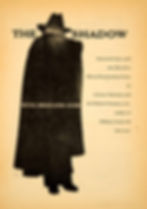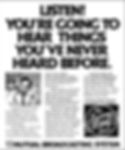The Forgotten Radio Network: The Mutual Broadcasting System
- FLAPPER PRESS
- Apr 10, 2020
- 5 min read
By John C. Alsedek:

Those of us who are of a certain age (read Gen X or older) remember when television largely consisted of the "Big Three": ABC, NBC, and CBS. So it was with radio as well—not surprising, since it was the same three networks! First up was the National Broadcasting Company (NBC), created by the Radio Corporation of America (RCA) in 1926. RCA also created a second branch network of NBC known as "NBC Blue Network". RCA would be forced to divest itself of NBC Blue in 1945, which led to the creation of the American Broadcasting Company (ABC). The Columbia Broadcasting System (CBS) also began operation in 1927, and the "Big Three" were alone on the national radio stage until 1934.
And then came the Mutual Broadcasting System.

The Mutual Broadcasting System (otherwise known as the Mutual Radio Network) worked on a model directly opposite to the other three networks; rather than the network owning the radio stations, the stations owned Mutual in a cooperative arrangement. Mutual’s original three member stations were WOR (Newark, NJ), WGN (Chicago, IL), and WLW (Cincinnati, OH), with the first two providing the lion’s share of the funding while WLW provided the biggest reach with its massive 500,000-watt signal. They were quickly joined by other stations, including WXYZ (Detroit, MI), which was a great addition because it produced the popular Western series The Lone Ranger. Mutual Radio’s programming came from the member stations; besides The Lone Ranger, it featured WGN’s highly rated Lum and Abner and WOR’s great anthology series The Witch’s Tale.
Within three years, Mutual Radio had expanded from coast to coast, adding a wide variety of individual stations and regional networks. Among the first was the Colonial Network in 1935, which consisted of Boston's WAAB and 13 other stations in New England. It was followed by the West Coast-based Don Lee Network, which left CBS to join Mutual, bringing four network-owned stations (KHJ-Los Angeles, KFRC-San Francisco, KGB-San Diego, and KDB-Santa Barbara) and eight affiliates in California & Hawaii; the 23-station Texas Network followed suit in 1937.

This expansion didn’t just mean new stations, it also meant new programs as affiliates brought their own productions into the mix. Best known of the bunch was The Shadow, which starred the great Orson Welles as both the titular crimefighter and his alter ego, Lamont Cranston. Other additions to the Mutual Radio lineup included The Green Hornet, Kay Kyser and His Kollege of Music Knowledge, and The Good Will Hour. Mutual Radio also acquired the exclusive rights to broadcast sporting events such as the World Series and the Indy 500, and its news bureau was a qualitative match for those of the three major networks.
But while Mutual Radio had grown to match its competitors in terms of content and number of stations, it still lagged far behind in one key area: advertising revenue. In 1940, for example, NBC brought in eleven times as many advertising dollars as Mutual. The reason? Mutual’s affiliates were largely either in small markets or were second bananas in larger markets. This would be Mutual Radio’s biggest issue through much of its existence and would lead to some of their biggest programs—including its original hit, The Lone Ranger—jumping ship to NBC, ABC, or CBS.
Still, Mutual Radio continued to grow during the 1940s and 1950s, becoming a leader in radio drama. Though The Lone Ranger left, it was replaced by The Adventures of Superman, which aired from 1942 to 1949. The Return of Nick Carter (later renamed Nick Carter, Master Detective) would run from 1943 until 1955. The Mysterious Traveler, an anthology series in the vein of the earlier The Witch’s Tale, aired from 1943 until 1952. Quiet Please, another anthology—this one by Lights Out creator Wyllis Cooper—ran from 1946 until 1947. Box 13, a mystery show starring Alan Ladd, was on from 1948 until 1949. And The New Adventures of Sherlock Holmes, which brought in Basil Rathbone and Nigel Bruce to reprise their roles from the Universal Sherlock Holmes films, was on the air from 1943 until 1946. Mutual also had successful game shows such as Twenty Questions and Queen for a Day, as well as star vehicles such as Kate Smith Speaks and its companion program, Kate Smith Sings.

In 1952, the Mutual Broadcasting System underwent a structural change as General Tire took over majority ownership, thereby signaling an end to Mutual’s cooperative days. General Tire was able to do so by first purchasing all the Don Lee Network's stations and Mutual stock when Lee passed away, and then purchasing General Teleradio (the company that owned Mutual anchor station WOR and others). But General Tire didn't remain for long; it sold Mutual to a group headed by Dr. Armand Hammer in 1957, who in turn sold Mutual a year later to the Scranton Corporation. The Scranton Corporation’s boss, Alexander Guterma, planned to create a media powerhouse by combining Mutual with another recent purchase, Hal Roach Studios; however, Guterma never got to see that happen, as he got into major legal trouble and resigned from the Scranton Corporation.
Things only got worse from there for Mutual Radio. Advertising revenue, always an area where Mutual lagged behind the other major radio networks, was drying up across the industry as major sponsors moved over to television—and the top talent was following suit. In the fall of 1959, the Scranton Corp. put Mutual into Chapter 11 bankruptcy; and then a bizarre case emerged in which Guterma and the other two top men with the Scranton Corp. were charged with taking money from the Dominican Republic in exchange for favorable coverage of its government by Mutual’s news bureau. The result of the two events was that over 130 stations severed ties with Mutual—including one of its originals, WOR.
Still, Mutual Radio soldiered on. In the spring of 1960, the 3M Company bought Mutual and gave it some stability through the bulk of the sixties, as Mutual finished transitioning from an all-purpose network to strictly news and sports. Then, in 1975, Mutual revolutionized the radio industry by creating the first-ever national all-night call-in show. It was hosted first by Herb Jepko, then Long John Nebel, and then Candy Jones; however, it didn’t really take off until a hitherto-unknown Miami talk show host named Larry King took over on January 30, 1978. King would stay with Mutual Radio until 1994, becoming the most popular program in the network’s history in the process. That time period also saw a brief return to radio drama, as Mutual Radio Theater (previously Sears Radio Theater) aired from 1980–1981.
By the mid-eighties, though, the handwriting was on the wall for Mutual Radio. Amway, the network’s last corporate owner, grew tired of not seeing a profit from its investment and sold Mutual to syndication giant Westwood One in 1985 for $39 million. Over the next decade, Mutual became nothing more than a brand name for a package of news and sports programming. And then, it wasn’t even that: on March 7th, 1999, Westwood One dropped the use of the name Mutual Radio following that night’s broadcast, without so much as a word of remembrance for what had once been one of the U.S.’s four great networks.
And speaking of four great networks . . . did you know that there were also four networks in the early days of television? We’ll be talking about the "forgotten" network, DuMont, next time. Until then, thanks for tuning in!
And speaking of tuning in, here’s an episode of my radio drama, SUSPENSE, that would have been right at home on one of Mutual Radio’s old anthology.
Writer, producer, and radio-drama aficionado, John C. Alsedek, shares the history of radio and the impact it has made on the world of entertainment.






